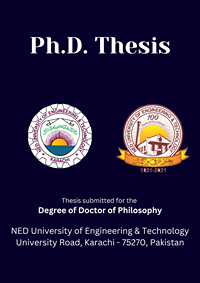Numerical Investigation of Current Transport Properties of Hot Carrier Devices (PhD Thesis)
Material type: TextLanguage: English Publication details: Karachi : NED University of Engineering and Technology Department of Mathematics, 2021Description: xvii, 406 p. : illSubject(s): DDC classification:
TextLanguage: English Publication details: Karachi : NED University of Engineering and Technology Department of Mathematics, 2021Description: xvii, 406 p. : illSubject(s): DDC classification: - 621.381520378242 NOS
| Item type | Current library | Shelving location | Call number | Status | Date due | Barcode |
|---|---|---|---|---|---|---|
 Reference Collection
Reference Collection
|
Reference Section | Reference Section | 621.381520378242 NOS | Available | 98708 | |
 Reference Collection
Reference Collection
|
Reference Section | Reference Section | 621.381520378242 NOS | Available | 98709 |
Abstract :
During the last few decades, the research community has been shown their interest to explore a wide band gap semiconductor material ZnO because of its exceptional properties. The fundamental structure of semiconductor devices is based on metal semiconductor contact. From the variety of metal semiconductor contact, devices based on Schottky contact are considered most significant device which revealed excellent electrical properties. The current transport mechanism and electrical parameters like ideality factor, barrier height, saturated current, built- in- potential etc. provide the information about the electrical behavior of devices.
In this study, Schottky diode made from ZnO has been considered because in the fabrication of high-quality devices exceptional properties of ZnO play crucial role. The main objective of this work is to study the current-voltage (1-V) and capacitance-voltage (C-V) characteristics of devices at highly sensitive temperature i.e. 300K-1000K.The impact of highly sensitive temperature on electrical parameters of Schottky diode was taken under consideration.
Mathematical modeling is the most time and cost-effective tool which is very helpful to investigate the properties of devices before fabrication, therefore in this study a mathematical approach was used to discuss mechanism of transportation of current in Schottky diode under highly sensitive temperature.
In paper 1, mechanism of current transport in forward bias direction was analyzed by using thermionic emission model and Cheung function. Effect of temperature from 300K- 1000K on parameters like ideality factor, barrier height and series resistance were discussed. Results obtained from both methods were compared with each other.
In paper 2, current-voltage aspect in forward bias and capacitance-voltage aspect in reverse bias of Schottky diode was discussed by employing two well-known iterative methods Newton-Rapson (NR) and Gauss- Seidel (GS) on standard equations of thermionic emission and capacitance-voltage in a wide range of temperature 300K- 1000K. In this paper results obtained by NR and GS method of temperature dependent ideality factor, saturated current, donor concentration and built- in- potential was compared. Discrepancy between the values of barrier height obtained by I-V and C-V was also discussed.
All the simulation in this research has been performed by using MATLAB algorithm. All the parameters were strongly dependent on temperature. Results of I-V aspects show that Ideality factor decreases and saturated current increases with increase in temperature while built- in- potential and donor concentration which were obtained by using C-V aspects show indirect relation with temperature. Barrier height was calculated by using I-V and C-V aspects both and obtained results show in I-V aspect barrier height is directly proportional while in C-V aspects it is inversely proportional with temperature. Results obtained from both papers show consistency with each other and with previously published reports.
